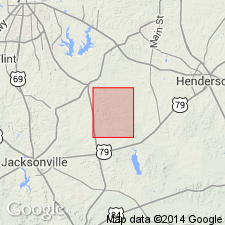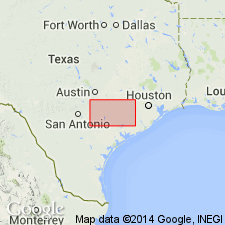
- Usage in publication:
-
- Plum bentonite
- Modifications:
-
- Original reference
- Dominant lithology:
-
- Bentonite
- AAPG geologic province:
-
- Gulf Coast basin
Summary:
Pg. 45, 46. Plum bentonite in Manning formation. Name applied to bentonite bed in Manning formation. Thickness 1.5 feet. Bentonite can be traced as separate lenses southwestward for 50 miles to region of Hells Gate on Guadalupe River in Gonzales County, central Texas. Age is Eocene.
Named from occurrence in vicinity of village of Plum, Fayette Co., central TX.
Source: US geologic names lexicon (USGS Bull. 1200, p. 3066).

- Usage in publication:
-
- Plum Bentonite [unranked]
- Modifications:
-
- Areal extent
- AAPG geologic province:
-
- Gulf Coast basin
Summary:
Plum Bentonite [unranked] in Manning Formation. Bentonite, indurated, waxy, conchoidal fracture, light yellowish to white. Thickness 1.6 feet near Plum, Fayette Co., southeastern TX. Age is Eocene.
Not separately mapped. (Manning Formation undivided mapped in Karnes, Gonzales, and Fayette Cos., southeastern TX.)
Source: Modified from GNU records (USGS DDS-6; Denver GNULEX).
For more information, please contact Nancy Stamm, Geologic Names Committee Secretary.
Asterisk (*) indicates published by U.S. Geological Survey authors.
"No current usage" (†) implies that a name has been abandoned or has fallen into disuse. Former usage and, if known, replacement name given in parentheses ( ).
Slash (/) indicates name conflicts with nomenclatural guidelines (CSN, 1933; ACSN, 1961, 1970; NACSN, 1983, 2005, 2021). May be explained within brackets ([ ]).

